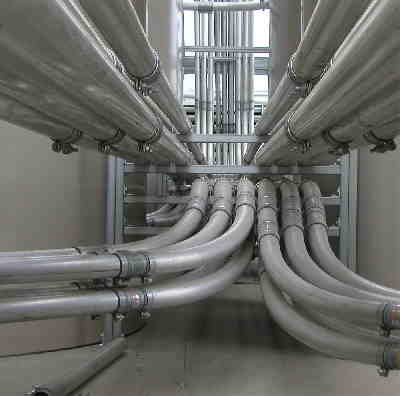One of the most important bulk solids handling techniques in a solids handling plant is solids transport. When this is done by solids suspended in a stream of air this is called pneumatic conveying and this can be done over horizontal, inclined or vertical surfaces, ranging from a few to several hundred meters. This transportation method can handle material sizes from fine powder to mm-sized granules depending on the diameter of the pipeline. Compared to other conveying methods, pneumatic conveying can provide a very flexible combination of pipelines. The range of materials that can be transported by pneumatic conveying is based on the physical property of the certain material. Particle size, hardness, resistance to damage and cohesive properties are key factors in determining whether a material is suitable for this conveying method. Most of the cohesive and sticky materials are often not suitable for a pneumatic conveying process. Materials with high oil and fat contents can e.g. easily cause pipeline blockage.
Pneumatic conveying can be catalogued into two main types based on the relative solids locating and velocity system. These two types are entitled as diluted phase and dense phase. Dense-phase pneumatic conveying is normally used to transfer particulate solids within short distances. The advantage of the diluted-phase pneumatic conveying is (1) relatively cheaper, (2) easier to maintain, (3) the pipeline design has more flexibility for small space. The advantage of the dense-phase pneumatic transport is (1) the high loading, (1) relatively low extent of attrition in the system, (3) transporting at high density with low air velocity can reduce the phenomena responsible for segregation of mixture.
In our field testing area, we have several small-scale pneumatic transport testing set-ups with radius bends and mitered bends to study the impact of various variables on conveying by means of pneumatic transport: the number of bends, type of bend, air velocity, dense phase vs. dilute phase.
This enables to determine in an early stage of the process design and product development whether the product properties are suitable for conveying by means of pneumatic transport. There are several common problems which occurs in the pneumatic conveying system:
Breakage and dusting of fragile materials
Friable material such as protein food, coffee beans or grains impact the bend wall at high speed which causes breakage and formation of fines. This can decrease the product quality, consistency and saleability while increasing waste and fine.
Wear and failure when conveying abrasives
Abrasive materials such as sand, glass, alumina or mineral-filled plastic pellets hit the outside radius of conventional impact bends at high speed. It can cause a continuous wearing of the bend wall. This problem can induce never-ending replacement of bends, additional labour and down-time of the process.
Plugging, streamers, filamentous and snake skins
When conveying pressure and/or heat-sensitive materials such as sugar, rubber pellets, adhesives and clay, the fraction between material and wall can produce heat and melt the material, which can lead to adhesive forces with the wall thereby causing product build-up. In the end, the product build-up can cause pipeline blockage.
Pellets skidding against the outside radius of conventional bends create friction and heat. The heat can potentially melt pellet surfaces and form streamers, filamentous and snake skins.
After the pneumatic conveying process, several analytical measurements such as repeated impact test can be used as a correlation method to extrapolate the conveying effect on the particles. Meanwhile, image analysis can be used to measure the particle size and shape before and after the pneumatic conveying in order to determine the potential attrition or abrasion of the particles.




